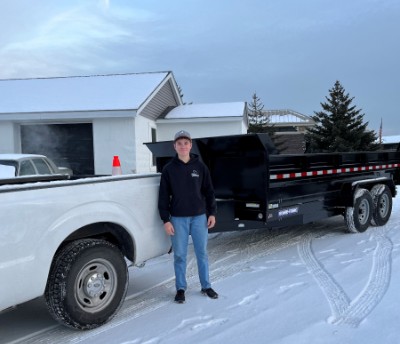 Griffin Tautges, now a junior at Germantown High School, started mowing lawns when he was in fifth grade and enjoyed it so much, he kept adding customers throughout middle school. Today, his business, GT Outdoor Solutions LLC, is a year-round venture, offering landscaping and snow/ice management services. At its busiest, Griffin is still able to work solo 60 percent of the time, with his buddies pitching in the rest of the time. His big goal—To grow GT into one of the largest landscaping companies in the states—will challenge Griffin to learn new skills. How can schools support young entrepreneurs?
Griffin Tautges, now a junior at Germantown High School, started mowing lawns when he was in fifth grade and enjoyed it so much, he kept adding customers throughout middle school. Today, his business, GT Outdoor Solutions LLC, is a year-round venture, offering landscaping and snow/ice management services. At its busiest, Griffin is still able to work solo 60 percent of the time, with his buddies pitching in the rest of the time. His big goal—To grow GT into one of the largest landscaping companies in the states—will challenge Griffin to learn new skills. How can schools support young entrepreneurs?
Business and marketing education classes help. In his sophomore year, Griffin took an entrepreneurship class. There, he created a business plan, which addressed how to grow the company through marketing and other business processes.
 “[The class] really struck home with me,” says Griffin, who recalls working on some of these areas in his middle school years with his dad. “The financial aspects were a real wake-up call for me,” he adds. These included banking and taxes, how to quote jobs, and how to invoice.
“[The class] really struck home with me,” says Griffin, who recalls working on some of these areas in his middle school years with his dad. “The financial aspects were a real wake-up call for me,” he adds. These included banking and taxes, how to quote jobs, and how to invoice.
That same sophomore year, he says, “I really started getting my ducks in a row.” And here’s where schools can really step up.
Supporting Young Entrepreneurs with Work-Based Learning Experiences
If your school has a promising entrepreneur, creating a work-based learning experience can provide support and credit. Griffin participates in an agricultural Youth Apprenticeship (YA). DPI partners with the Wisconsin Department of Workforce Development (DWD) to offer YA. To learn more about this option, contact your local YA coordinator or DWD.
Schools may also offer a student entrepreneurial experience (SEE). Here are steps schools might take to create an SEE, which combines classroom learning and an out-of-school or simulated work experience:
• A student (or group of students) starts their own landscaping business with an employer-mentor.
• There is a progressive outline of tasks and a training agreement between the employer-mentor, school, and student(s).
• The school ensures that the student business follows quality principles of business operation and provides credit for the experience.
• Monies from landscaping services are part of the business model.
When WBL is incorporated into a classroom, time spent learning must be separated from time spent working (even if it is work simulation). A student must log at least 90 hours of working to count as a WBL experience. Some courses, especially year-long courses, may include 90 hours of work directly into the class period and still have adequate time for learning. All six WBL criteria* need to be met for both YA and SEE.
Griffin’s Next Steps
Griffin’s time management skills will be tested as he plans to study horticulture and landscape construction after high school. On the business side, he wants to learn more about collections and scheduling jobs/employees. We wish Griffin the best of luck in reaching his goal!
*See The Wisconsin Guide to Implementing Career-Based Learning Experiences, page 6, to view the six criteria for a course to qualify as a Perkins V work-based learning experience.
